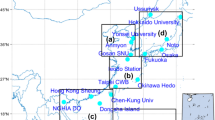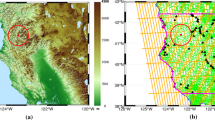Abstract
This paper presents the compact polarized (CP) pseudo quad-pol parameters for the detection of marine oil spills and segregation of lookalikes using simulated CP SAR data from full-polarized (FP) SAR imagery. According to the CP theory, 11 polarized parameters generally used for the detection of oil spills were derived from reconstructed pseudo quad-pol data for both C and L bands. In addition, the reconstruction performance between C and L bands was also compared by evaluating the reconstruction accuracy of retrieved polarized parameters. The results show that apart from σHV and RH, other polarized parameters of σHH, σVV, H, α, φH–V, r, ρH–V, and γ can be reconstructed with satisfactory accuracy for both C and L bands. Furthermore, C band has a higher reconstruction accuracy than L band, especially for φH–V. Moreover, the effect of reconstruction of polarized parameters on oil spill classification was also evaluated using the maximum likelihood classification (MLC) method. According to the evaluation of kappa coefficients and mapping accuracy, it is recommended to use σHH, σVV, H, ρH–V, and γ of the C band CP SAR for marine oil spill classification.
Similar content being viewed by others
Reference
Brekke C, Solberg A H 2005. Oil spill detection by satellite remote sensing. Remote Sens Environ, 95(1): 1–13
Buono A F, Nunziata M, Migliaccio X, Li X 2016. Polarimetric analysis of compact-polarimetry SAR architectures for sea oil slick observation. IEEE Trans Geosci Remote Sens, 54(10): 5862–5874
Buono A, Nuziata F, Migliaccio M 2015. On the capability of compactpolarimetry SAR architectures to observe oil slicks at sea. In: Proceedings of PolINSAR 2015 Workshop
Collins M J, Denbina M, Minchew B, Jones C E, Holt B 2015. On the use of simulated airborne compact polarimetric SAR for characterizing oil–water mixing of the Deepwater horizon oil spill. IEEE J Sel Top Appl Earth Obs Remote Sens, 8(3): 1062–1077
Dabboor M, Singha S, Topouzelis K, Flett D 2017. Oil spill detection using simulated radarsat constellation mission compact polarimetric SAR data. In: Geoscience and Remote Sensing Symposium
Fingas M, Brown C 2014. Review of oil spill remote sensing. Mar Pollut Bull, 83(1): 9–23
Frost V S, Yurovsky L S 1985. Maximum likelihood classification of synthetic aperture radar imagery. Comput Vis Graph Image Process, 32(3): 291–313
Kumar L J V, Kishore J K, Rao P K 2014. Decomposition methods for detection of oil spills based on RISAT-1 SAR. International Journal of Remote Sensing & Geoscience, 3(4): 1–10
Majd M S, Simonetto E, Polidori L 2012. Maximum likelihood classification of high-resolution SAR images in urban area. Photogramm Fernerkund Geoinf, (4): 395
Migliaccio M, Gambardella A, Tranfaglia M 2007. SAR polarimetry to observe oil spills. IEEE Trans Geosci Remote Sens, 45(2): 506–511
Nord M, Ainsworth T, Lee J, Stacy N J S 2009. Comparison of compact polarimetric synthetic aperture radar modes. IEEE Transactions on Geoscience & Remote Sensing, 47(1): 174–188
Nunziata F, Migliaccio M, Li X 2015. Sea oil slick observation using hybrid-polarity SAR architecture. IEEE J Oceanic Eng, 40(2): 426–440
Salberg A B, Rudjord O, Solberg A H S 2014. Oil spill detection in hybrid-polarimetric SAR images. IEEE Trans Geosci Remote Sens, 52(10): 6521–6533
Shirvany R, Chabert M, Tourneret J Y 2012. Ship and oil-spill detection using the degree of polarization in linear and hybrid/compact dual-pol SAR. IEEE J Sel Top Appl Earth Obs Remote Sens, 5(3): 885–892
Solberg A H S 2012. Remote sensing of ocean oil-spill pollution. Proc IEEE, 100(10): 2931–2945
Solberg A H S, Brekke C, Husoy P O 2007. Oil spill detection in Radarsat and Envisat SAR images. IEEE Trans Geosci Remote Sens, 45(3): 746–755
Souyris J C, Imbo P, Fjortoft R, Mingot S 2005. Compact polarimetry based on symmetry properties of geophysical media: the p/4 mode. IEEE Trans Geosci Remote Sens, 43(3): 634–646
Touzi R, Charbonneau F 2014. Requirements on the calibration of hybrid-compact SAR. In: Geoscience and Remote Sensing Symposium, 1109–1112
Velotto D, Migliaccio M, Nunziata F, Lehner S 2011. Dual-polarized TerraSAR-X data for oil-spill observation. IEEE Trans Geosci Remote Sens, 49(12): 4751–4762
Wang W, Lu F, Wu P, Wang J 2010. Oil spill detection from polarimetric SAR image. International Conference on Signal Processing IEEE, 832–835
Yin J, Yang J, Zhou Z S, Song J 2015. The extended Bragg Scattering model-based method for ship and oil-spill observation using compact polarimetric SAR. IEEE J Sel Top Appl Earth Obs Remote Sens, 8 (8): 3760–3772
Zhang B, Li X, Perrie W, Garcia-Pineda O 2017. Compact polarimetric synthetic aperture radar for marine oil platform and slick detection. IEEE Transactions on Geoscience & Remote Sensing, 55(3): 1407–1423
Zhang X, Zhang J, Liu M, Meng J 2016. Assessment of C-band compact polarimetry SAR for sea ice classification. Acta Oceanol Sin, 35(5): 79–88
Zhang Y, Zhang J, Wang Y, Meng J, Zhang X 2015. The damping model for sea waves covered by oil films of a finite thickness. Acta Oceanol Sin, 34(9): 71–77
Zheng H, Zhang Y, Wang Y 2015. Oil spill detection based on polarimetric feature SERD. Transactions of Oceanology and Limnology, (4): 173–180
Acknowledgements
The authors gratefully acknowledge the financial supports from the National Basic Research Program of China (Nos. 2016YFB0502504 and 2016YFB0502500) and the National Natural Science Foundation of China (Grant Nos. 41431174, 61471358, 41671359, and 41401427), the ALOS research program (PI1404). This article is partly sponsored by the Funding of Scholarship of Chinese Academy of Sciences. The authors would also acknowledge Professor Zhang from the First Institute of Oceanography, State Oceanic Administration, for supporting research on CP theory.
Author information
Authors and Affiliations
Corresponding author
Rights and permissions
About this article
Cite this article
Wang, X., Shao, Y., Zhang, F. et al. Comparison of C- and L-band simulated compact polarized SAR in oil spill detection. Front. Earth Sci. 13, 351–360 (2019). https://doi.org/10.1007/s11707-018-0733-9
Received:
Accepted:
Published:
Issue Date:
DOI: https://doi.org/10.1007/s11707-018-0733-9




